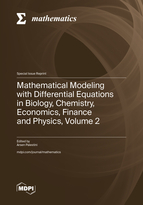Mathematical Modeling with Differential Equations in Biology, Chemistry, Economics, Finance and Physics, Volume 2
A special issue of Mathematics (ISSN 2227-7390). This special issue belongs to the section "Difference and Differential Equations".
Deadline for manuscript submissions: closed (31 December 2023) | Viewed by 13495
Special Issue Editor
Interests: game theory; ordinary differential equations; mathematical economics; voting games
Special Issues, Collections and Topics in MDPI journals
Special Issue Information
Dear Colleagues,
Due to the success of the previous Special Issue of Mathematics that was be wholly devoted to the wide and deep topic of differential equations and their applications in diverse fields, it is a pleasure for us to introduce Volume 2 of the same Special Issue. It is well known that an incredibly large number of physical, chemical, biological, financial, and economic phenomena are commonly and accurately described by various kinds of differential equations (ODEs, PDEs, SDEs, dynamical systems, and so on). Once again, our aim is to collect a large number of contributions written by several mathematicians and related researchers and scholars to exhibit some of the current trends and the newest findings in this special field. We anticipate that many types of application and theoretical insight shall be covered, and we are hopeful that the manuscripts submitted will have a high mathematical level. For any enquiry, feel free to contact us.
Dr. Arsen Palestini
Guest Editor
Manuscript Submission Information
Manuscripts should be submitted online at www.mdpi.com by registering and logging in to this website. Once you are registered, click here to go to the submission form. Manuscripts can be submitted until the deadline. All submissions that pass pre-check are peer-reviewed. Accepted papers will be published continuously in the journal (as soon as accepted) and will be listed together on the special issue website. Research articles, review articles as well as short communications are invited. For planned papers, a title and short abstract (about 100 words) can be sent to the Editorial Office for announcement on this website.
Submitted manuscripts should not have been published previously, nor be under consideration for publication elsewhere (except conference proceedings papers). All manuscripts are thoroughly refereed through a single-blind peer-review process. A guide for authors and other relevant information for submission of manuscripts is available on the Instructions for Authors page. Mathematics is an international peer-reviewed open access semimonthly journal published by MDPI.
Please visit the Instructions for Authors page before submitting a manuscript. The Article Processing Charge (APC) for publication in this open access journal is 2600 CHF (Swiss Francs). Submitted papers should be well formatted and use good English. Authors may use MDPI's English editing service prior to publication or during author revisions.
Keywords
- ODE
- SDE
- PDE
- dynamical systems
- closed form solutions
- applications
- differential games
- optimal control
- complex differential equations
- Nash equilibrium
- steady state
- difference equations






